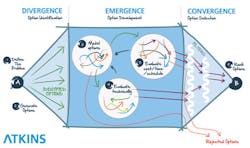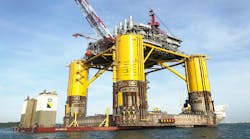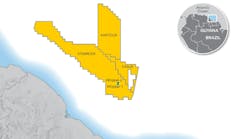Consultancy group examines ‘non-linear’ process
Conor Crowley
Atkins Oil and Gas
Last year’sWood Review of oil and gas production in the UK continental shelf (UKCS) highlighted the challenges of a mature basin, with marginal fields which may never be developed without concerted engineering and collaborative effort. For many of these fields, no economic development plan exists, and the time is ticking to allow these to ever be developed with infrastructure decommissioning looming.
Management of the project delivery phases is well understood, with focus on fixed scope, management of change, and schedule risk. How to best tackle the conceptual phases of project development is not as well defined.
Marginal field development in many ways focuses the engineering challenge into the early phase of the project. A project cannot progress until at least one economic solution is found. In a mature basin like the UKCS, the design will often be heavily influenced by access to infrastructure, either to host, control, process or export the hydrocarbon, meaning that the design will also need to overcome additional constraints over and above greenfield development.
Concept development
The conceptual development process is inherently difficult to proceduralize, as in general there are not large amounts of time, money, or details available to answer every potential design question and there is little engineering basis. Decisions have to be taken which precede the detailed engineering that would justify them.
Atkins’ oil and gas division has reviewed the conceptual work it has carried out, including 10 years worth of concept development studies, and has outlined a framework to capture its approach.
While the process tends to be non-linear, it generally follows six main activities:
1. Define the problem
With potentially competing goals and often significant uncertainty over the fundamental inputs and outcomes, it is not trivial to define the problem that is to be resolved at the start.
When working with client teams, it is important to understand what their understanding of what project success looks like, as a combination of technical, safety, environmental, and economic/commercial factors. This may also involve getting a feel for a maximum supportable capex.
2. Generate options
The options generation phase is an inherently creative process, with a team of engineers taking the project objectives and finding a concept or concepts that may work.
This is like generating a new Lego model. With a wide knowledge of all the potential “bricks” in the concept box, candidate option or options are pieced together into viable concepts.
3. Model options
A model is defined here as a set of ideas, numbers, and simplified representations that describe the present, and/or future state of a development. It encompasses the process, and also the structures, vessels, pipelines, people, systems, and facilities required to support those processes.
In modeling options, the basic idea of each concept is tested to determine its likely outcomes in terms of product and requirements. The model needs to be as simple as possible, but no simpler, reflecting the particular constraints of the situation, and the uncertainties inherent in the inputs. It needs to be robust enough that the model can adequately describe the impact of any changes on the concept.
This model is generally owned by one engineering discipline, but informed by other relevant disciplines. A process engineer may define what the process scheme will look like, but will need to understand the effect of pipeline design on operability, along with the impact of the weight on the structure and how that is supported through using fixed or floating designs. Equipment will need to be controlled, powered, and supplied with whatever utilities are appropriate. The concept needs be safe enough, and be able to handle major accident hazards.
4. Evaluate technically
Not every discipline can be represented in the modeling process, and the simplified representation cannot capture all potential pitfalls. As a result, the design concept is presented to the wider engineering team, and often to the client and partners, to test the robustness of the concept. The goal is to uncover any fundamental issues with the concept that would make it infeasible.
The key is to be able to make decisions about the design that take account of the uncertainties inherent in the concept development. This conceptual evaluation ability is not universal among engineers.
5. Evaluate cost, timeline
Engineering is often about the art of the possible, and the most elegant concept may fall down when it comes to how long it takes to implement, or how much it costs. This is likely to require high-level cost modeling, and also an understanding of the time and resources required to complete the project. Where this involves brownfield modifications, scheduling work relative to other competing schedules and accommodating the time required for tie-ins and other modifications adds layers of complexity.
6. Rank options
With the project goals outlined, and the costs, benefits and issues associated with of the option or options worked up in subsequent phases, the concept phase is best closed with a ranking exercise. This may be fully quantitative, using an economic model to evaluate the options. More commonly, some tests may screen out options (e.g. maximum capex, minimum or maximum schedule, etc.); the remaining options are ranked relative to each other, by a combination of qualitative and quantitative measures. This then informs the recommendation on which concept or concepts are taken forward to the next phase (pre-front-end engineering and design or FEED).
The framework is itself a simplified model of the processes taking place during conceptual studies, with arrows in multiple directions to suggest the fact that depending on the project, the steps may well be repeated, run in parallel, or in some situations, be omitted entirely. Studies seldom run in isolation, and it is very common for fundamental parameters of the study to change during the study, in response to developing reservoir modeling, economic evaluation, and commercial negotiation.
Design agility
The process also follows three models, detailed as follows:
Behaviors and engineering approach. The conceptual phase of a project is ultimately about describing the future state of the facilities once the project is complete, rather than developing the deliverables allowing tender and procurement of facilities.
It requires not only that engineers apply their domain knowledge in option generation, but also to be comfortable in divergent, emergent, and convergent thinking. Making decisions without detailed analysis can be challenging. Depending on the drivers for the project, this will often be led by generalist disciplines such as process and subsea.
While generalist disciplines tend to have wide cross-disciplinary knowledge, this is augmented by specific discipline input in areas such as structures and marine, power, mechanical, instrumentation, cost, and planning. The full picture will generally be better with wider discipline and specialist input as appropriate.
A complex environment.By definition, marginal fields require optimization of their economic performance to ever leave the metaphorical drawing board, and in many cases, this may require pushing the limits of conventional approaches.
Utilizing space on an existing installation to process new fluids will change the loading on a jacket structure, but will also change the potential life of the structure. Many of the structures and vessels in use in the North Sea are now heading for operation 30-50 years beyond their initial life. The Forties field, for example, is now looking to 2030 and beyond, with the original structures in use since 1975.
One must also be mindful of the fact that the offshore oil and gas production industry is a high hazard industry. Those in the field are dealing with flammable hydrocarbon, often at high pressures, and the fluids being processed change day-to-day and year-to-year.
Economies of scale. Conventional wisdom suggests bigger is always better. However, during concept design, it is critical to test this view, particularly with marginal fields. In trying to justify large capital investment, it is natural to look for upside in production rates, the size of the reservoir, scope for later tiebacks, all of which drive up the size and cost of any facility. When combined with the additional drilling and subsea development costs, things can get rapidly out of hand. Similarly, the push to maximize initial production rate and reservoir net present value to meet growing capex fuels the fire. Concept development should always include multiple field development economic alternatives. Staged developments using smaller, lower cost facilities to get first oil and cash flowing as soon as possible represent a sound risk reduction measure, not least because they often lead to strategies naturally suited to life extension, and less exposed to oil price fluctuations.
Perhaps the most recent example of this type of agile thinking is Premier Oil’s Sea Lion project. The effect of the falling oil price was quickly matched with an alternative solution more suited to the changing economic climate, and quickly adopted as it had already been considered as an option at the conceptual stage.
Case studies
The following case studies provide examples of how the above-described process has been successfully applied.
Weight versus cost. Much of design is compromise, and the challenge offshore is to provide the minimum facilities that will meet the export specifications, especially in areas without pipeline export facilities. Each additional process adds weight and area that require to be supported by either structures or floating facilities, a challenging cross-disciplinary conceptual problem. In developing a concept for an independent oil company west of Shetland, Atkins had to find a way to reduce the overall capital cost for a facility exporting via tanker. By careful iteration between process and structural, a minimum weight concept with a simplified process supported on an articulated tower, using a subsea tank for storage and export emerged. This concept unlocked the funding for the client and its investors to allow development wells to be drilled in the area. These turned out to have higher reserves than originally thought, allowing for more complex topsides to be justifiable, and unlocked the field for production.
Overcoming long distances. A recent high-pressure/high-temperature (HP/HT) subsea tieback in the UKCS faced the competing requirements of needing to minimize heat loss from the hydrate-prone gas condensate to ensure long cool-down times, while also needing to lose excess heat at the pipeline inlet in order to limit the levels of thermally-induced strain in the pipeline and limit the product arrival temperature at the processing facility.
Flow assurance, computational fluid dynamics, pipeline limit state design, and localized finite element analysis techniques were combined to develop an early understanding of the nature and scope of the problems to be resolved. Selected, targeted assessments were used to screen potential design concepts, and a successful design emerged. The project was sanctioned, and is now in commissioning.
Life extension. Unlike most other process industries, there is no real steady-state product stream over the production life, and design tends to focus on the early years of production. In some cases, facilities required later in field life have been properly examined to see if they can be operated or even commissioned.
Meeting the Wood Review challenge of extending infrastructure life revolves around being able to have a detailed understanding of processing plant capacity and capability, and finding economic ways to incorporate new hydrocarbon streams into existing facilities. This has been ongoing in the UKCS for a number of years now, and in supporting these conceptual developments, Atkins developed its MeasCap process evaluation tools. Key in this is the ability to quickly evaluate and re-evaluate the performance of a process against a range of operating cases, with those who have invested in these studies developing a better understanding of the ultimate performance of their plants against a changing demand profile.
Feasible solutions. Feasible solutions do not always exist. A recent study Atkins was involved in looked at a large variety of potential options for an HP/HT development. The approach requested by the client was to review all potential solutions, without demonstrating a viable base case first. As the reservoir modeling progressed, evaluation of the reserves meant that the economics of the field were not viable, but by casting such a wide net for potential options and trying to develop many concepts in parallel without testing that there was a good base-case, a large engineering effort was carried out to limited benefit.
Conclusions
In the current climate, there is limited budget to build many potential options. It is arguably therefore a good time to examine how concepts are best developed, and use the pause in investment frenzy that a downturn brings to calmly and systematically examine our development portfolios in order to maximize the returns when investment decisions are ultimately taken. •
Acknowledgments
This article is based on a paper presented at the Deep Offshore Technology International Conference & Exhibition held in Aberdeen, Scotland, Oct. 14-16, 2014.
The author
Conor Crowley graduated with a degree in Chemical Engineering from the Cork Institute of Technology. He is a process and safety engineer working with Atkins Oil and Gas in Aberdeen. He has been involved in conceptual process engineering with Atkins over the past 15 years, and has worked most recently on bringing process safety further into conceptual design. He is a Fellow of the Institution of Chemical Engineers in the UK.






